 The Plot
The Plot
Tommy isn’t exactly the coolest boy in the sixth grade, but he knows he’s cooler than Dwight. Which is why it’s so very confusing when Dwight, who has committed many crimes against coolness, produces an origami Yoda. And not just any origami Yoda, but a Yoda who gives great advice (if in a poor imitation of the actual Yoda’s voice). If Dwight is so incredibly out of the loop, how does Yoda do it? Is the Force really at work here or is it something else?
My Thoughts
The title of this book alone made it required reading, and then the cover (with its picture of an origami Yoda made by the author) just clinches the deal. But other than those things and the cover blurb, I didn’t have much more information about it going in.
The setting is a U.S. middle school, a fairly liberal one, as the kids seem to have plenty of time to congregate out of class (not a feature of the junior high I went to – though at least we still got a long enough lunch to have some recess time after eating). Tommy is a kind of middle of the road kid, perhaps on the less popular side of average, and his friends mostly occupy the same social stratum. Dwight is a boy on the fringe of their group — he’s considered borderline acceptable even by them, due to his behaviors and habits which are considered odd by the other kids.
Dwight, however, doesn’t seem to care or notice that he’s looked down upon by the others. He seems oblivious for the most part to the horror he creates when he wears a weird outfit or eats his food in an odd fashion, or talks to a girl without agonizing over it. It’s not clear to me as a reader if Dwight is meant to be socially awkward and unaware of the views of others or if he’s completely aware of their shock, but is just above petty social games and confident enough in himself to behave the way he wants. In the end it may not matter (we spend the book in Tommy’s head, not Dwight’s) but it’s an interesting question which I don’t entirely feel was resolved.
One day, Dwight shows up having made a Yoda out of origami. He puts it on his finger and does a Yoda imitation and thus proceeds to give advice to the others. Most of the time, this advice seems to be very wise, and most of the other kids find this completely incompatible with their view of Dwight as clueless. (Though it fits better with the possible second view of Dwight which none of them have entertained.) Tommy is one of the most concerned by this seeming divergence from expectations (perhaps because it forces him to think he may have mislabeled and underestimated Dwight?) and so he attempts to compile a dossier of the advice Yoda has given and the results which ensued.
The various scenarios presented are all reasonable, realistic and all that (well, maybe — do they really still have middle school dances? they were lame 20 years ago and not many people went), and the premise is a fine one. The only place where the story falls down a bit is in the fact that all the kids (except for Tommy’s cynical “friend” Harvey, who as far as this story actually has an antagonist, is it) sound exactly the same, even though we’re supposed to be getting stories from a variety of perspectives. Perhaps the stories are meant to have been filtered through Tommy before being written down. I’m not sure. But I would have liked to have seen a bit more variety in voice.
The other issue I had was with the girls. And in the context of the story, it’s not really a fault, it’s just a POV that’s so common I’d really like to see some effort to make it new again. And that is the view of girls as alien beings impossible to comprehend, a view which most of the boys seem to share. I’m not sure how one would make this new, but I do know it wasn’t exactly ‘new’ here.
Overall, this was a pleasant little story. By the end, Tommy seems to have learned a lesson, everyone is happy (except Harvey) and it ends on a feel good note. There is a sequel coming, which I find I’m actually interested to read, because it seems like it’s going to focus on Harvey and his reaction to all of these events.
In Short
Though The Strange Case of Origami Yoda doesn’t exactly break new ground in tween books, it’s still a decent story with some interesting characters. I really like the idea of the origami Yoda, and really it was that which attracted me to the book in the first place. (And shows what you can do with a kickass title.) Though most of the characters felt pretty generic, Dwight and Harvey (and to a certain extent Caroline, a hearing impaired student just slipped in there for no moral value at all — nice work!!) stood out as being unique constructs. I’ll be picking up the sequel to see what happens next.
Origami Yoda
Edited to add my not so great attempt at making this version of Origami Yoda. The only origami paper I could find in the house was small and rainbow colored, neither of which helped.
[Yoda uses the force to prevent his picture being taken]

[Yoda’s force powers are overcome by sunlight]






 The Plot
The Plot
 The Plot
The Plot